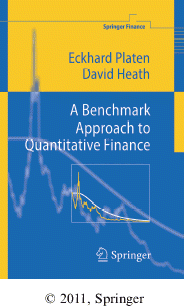
A Benchmark Approach to Quantitative Finance, by Eckhard Platen and David Heath, Springer (2006). ISBN: 3-540-26212-1.
This book presents a comprehensive and unifying treatment of Quantitative Finance based on the so-called benchmark approach that has been developed over recent years by E. Platen and co-workers. This approach is characterized by the central role assigned to the growth optimal portfolio (GOP): for portfolio optimization it serves as a benchmark, while for pricing and hedging it can be taken as numeraire, whereby the real world (physical) measure P becomes the pricing measure, namely GOP denominated prices are P−martingales. This latter aspect leads to various advantages, for example when it comes to using estimation procedures (filtering and/or parameter estimation). The major advantage is that it allows pricing and hedging to be performed also in situations when a classical local martingale measure does not exist. In this sense the benchmark approach is also in line with current investigations that take into account the fact that in various financial applications a local martingale may not be a true martingale and, in particular, the density process for a candidate (local) martingale measure may be a strict supermartingale. An important result in this context concerns furthermore the fact that a market may be complete without necessarily requiring the existence of a martingale measure. Typical examples to illustrate this situation in a diffusion-type model involve Bessel processes that are described in a systematic way in the book. Finally, the benchmark approach allows one also to establish a link between current mathematical finance methodologies and the more classical CAPM-based ones that are still in wide use, especially among practitioners.
We describe now in more detail the contents of the book that consists of fifteen chapters.
The first seven chapters, as well as part of chapters eight, nine and fifteen cover background material that for many aspects goes beyond what can be found in standard textbooks, in particular in view of the specific topic of the book. Chapters eight and nine deal with derivative pricing. While chapter eight presents an overview of standard derivative pricing, in chapter nine various alternative results for pricing according to the benchmark approach are discussed, in particular ‘fair pricing/real world pricing’ where GOP-denominated prices are martingales under the real world probability measure. Examples are given where the candidate density for a martingale measure is a strict local martingale, but the GOP still exists, demonstrating fair pricing to be more general than classical risk neutral pricing. Chapter ten is mainly devoted to the GOP and it is shown that it can be obtained without reference to a specific model, in particular, it can be approximated by well-diversified portfolios. Chapter eleven is dedicated to portfolio optimization thereby extending a range of classical results in this area. A central concept here is that of a ‘locally optimal portfolio’ and a two-fund type result is shown, namely that a locally optimal portfolio can be decomposed into two investments: a fraction of wealth held in the GOP and the remainder in the savings account. Locally optimal portfolios also turn out to be efficient in the Markowitz sense and they maximize the Sharpe ratio. Finally, it is shown how non-replicable payoffs can be priced according to utility indifference pricing and it turns out that such a price is a fair price, independently of the utility function. Chapters twelve and thirteen contain examples where the GOP exists, but not an equivalent martingale measure. In chapter fourteen the various results are extended to market models allowing for event risk, e.g. where securities may default. Since the GOP can be viewed as a diversified market portfolio, implying that the jumps become invisible to an observer of the GOP in the presence of event risk, it is then possible to make the assumption that the market price of event risk is zero. The final chapter fifteen constitutes a brief survey of basic numerical methods for quantitative finance, in particular scenario simulation, Monte Carlo simulation, tree based and finite difference schemes.
The book thus presents itself as a comprehensive treatment of Quantitative Finance and distinguishes itself from analogous treatments by using a novel approach, namely the benchmark approach. This allows one to extend various existing results to more general situations and at the same time allows one to bridge a certain gap between current and classical approaches.
Wolfgang Runggaldier
University of Padova